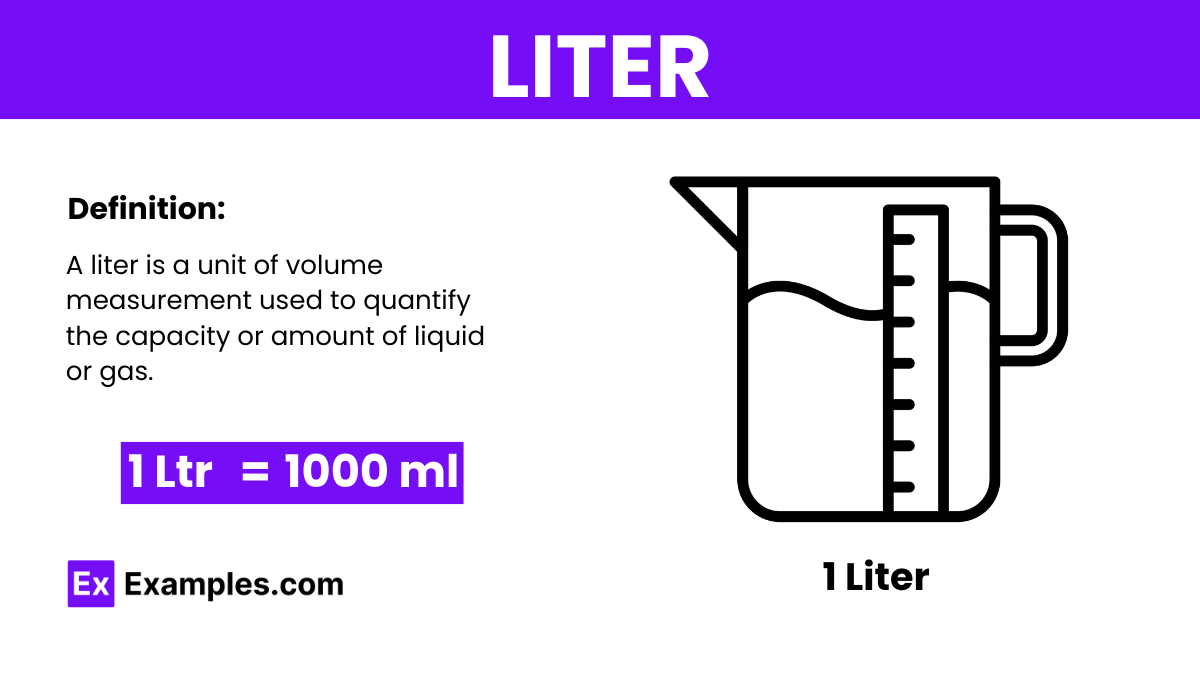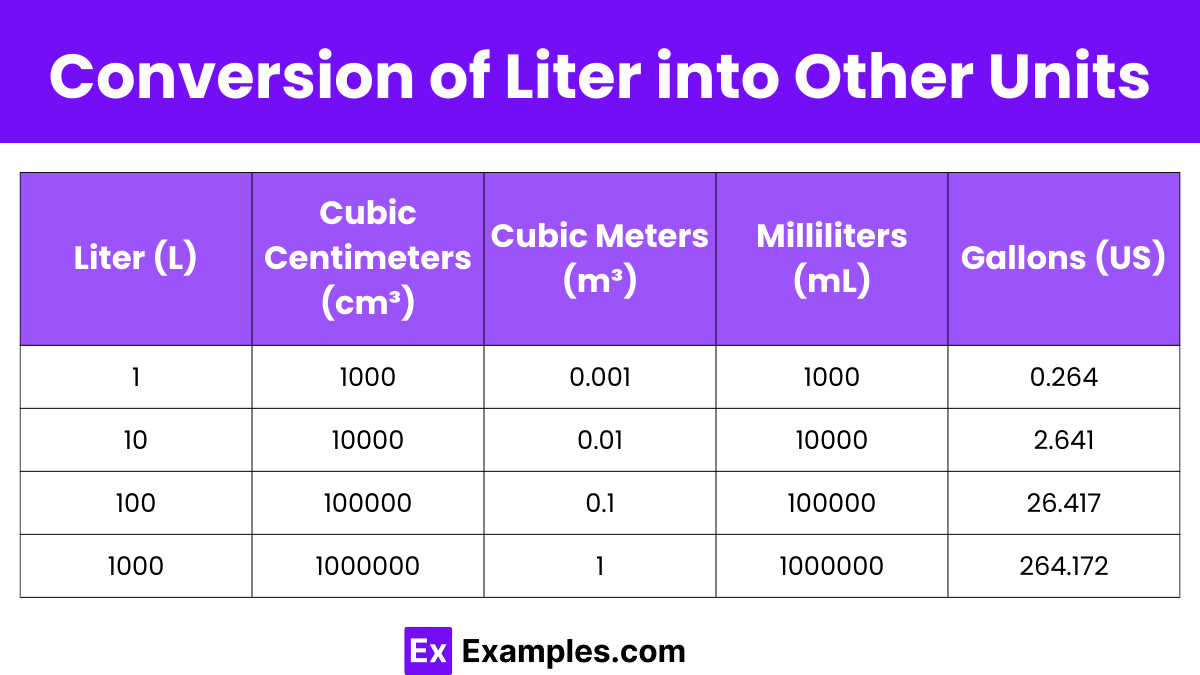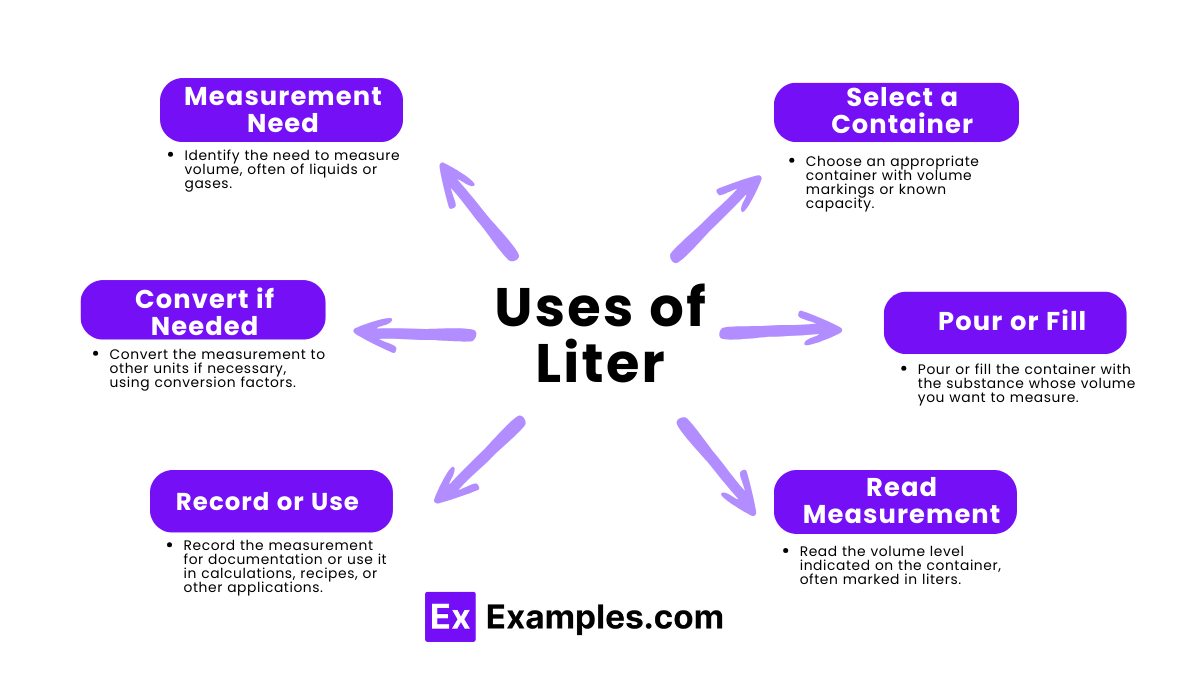What is the definition of a liter?
A unit of mass
A unit of length
A unit of volume
A unit of time


A liter is a unit used to measure volume, which basically means how much space something takes up. It’s commonly used for liquids like water or soda. It’s often written as “L” on labels or containers.
A liter is a unit of volume used to measure liquids and gases. It’s commonly abbreviated as “L”. One liter is equal to 1,000 cubic centimeters (cm³) or one cubic decimeter (dm³). In everyday terms, a liter is roughly equivalent to the volume of a standard bottle of water or soda.
| Shape | Formula |
|---|---|
| Cube or Rectangular Prism | Volume = Length × Width × Height |
| Cylinder | Volume = π × radius² × height |
| Sphere | Volume = (4/3) × π × radius³ |

| Liter (L) | Cubic Centimeters (cm³) | Cubic Meters (m³) | Milliliters (mL) | Gallons (US) |
|---|---|---|---|---|
| 1 | 1000 | 0.001 | 1000 | 0.264 |
| 10 | 10000 | 0.01 | 10000 | 2.641 |
| 100 | 100000 | 0.1 | 100000 | 26.417 |
| 1000 | 1000000 | 1 | 1000000 | 264.172 |
This conversion is based on the fact that 1 liter is defined as 1000 cubic centimeters. So, to convert from liters to cubic centimeters, you multiply the number of liters by 1000.
This conversion is derived from the relationship between the liter and the cubic meter. Since there are 1000 liters in a cubic meter, 1 liter is equal to 0.001 cubic meters.
This conversion is straightforward because the milliliter is defined as one-thousandth of a liter. So, to convert from liters to milliliters, you multiply the number of liters by 1000.
This conversion is based on the conversion factor between liters and gallons. Since 1 gallon is approximately 3.78541 liters, 1 liter is approximately equal to 1/3.78541 or 0.264 gallons
For Regular Shapes (Cube, Rectangular Prism):
Measure the length, width, and height of the object in the same unit (e.g., centimeters, meters).
Multiply these three dimensions together: Volume = Length × Width × Height.
The result will be in cubic units (such as cubic centimeters or cubic meters). To convert to liters, divide by 1000 if the measurements are in centimeters, or use the appropriate conversion factor if measurements are in other units.
For Irregular Shapes:
Use methods like displacement, where you submerge the object in a liquid with a known volume and measure the increase in volume, to find the object’s volume indirectly.
For Liquids in Containers:
Use a measuring cup or a graduated cylinder to directly measure the volume in liters. These containers usually have volume markings that indicate liters or milliliters.
For Gases:
If the gas is contained in a known volume, such as a cylinder or a container with volume markings, you can directly read the volume in liters.

To convert liters to cubic centimeters, multiply by 1000. To convert to cubic meters, divide by 1000. For milliliters, simply multiply by 1000. To convert to gallons (US), multiply by 0.264.
Liters are used to measure quantities of liquids in various contexts, such as cooking, fueling vehicles, filling containers, and determining capacities of tanks or reservoirs.
To convert liters to other units of volume, you can use conversion factors. For example, 1 liter is equal to 1000 cubic centimeters, 0.001 cubic meters, or 1000 milliliters. There are also conversion tables and online converters available for easy reference.
One liter of water is equivalent to 1000 milliliters or approximately 33.814 fluid ounces. It’s roughly the amount of water you’d find in a standard water bottle.

A liter is a unit used to measure volume, which basically means how much space something takes up. It’s commonly used for liquids like water or soda. It’s often written as “L” on labels or containers.
1 Ltr = 1000 Ml
A liter is a unit of volume used to measure liquids and gases. It’s commonly abbreviated as “L”. One liter is equal to 1,000 cubic centimeters (cm³) or one cubic decimeter (dm³). In everyday terms, a liter is roughly equivalent to the volume of a standard bottle of water or soda.
Volume (in liters) = Length × Width × Height
Volume (in liters) = π × radius² × height
Volume (in liters) = (4/3) × π × radius³
Shape | Formula |
|---|---|
Cube or Rectangular Prism | Volume = Length × Width × Height |
Cylinder | Volume = π × radius² × height |
Sphere | Volume = (4/3) × π × radius³ |
Liter (L) | Cubic Centimeters (cm³) | Cubic Meters (m³) | Milliliters (mL) | Gallons (US) |
|---|---|---|---|---|
1 | 1000 | 0.001 | 1000 | 0.264 |
10 | 10000 | 0.01 | 10000 | 2.641 |
100 | 100000 | 0.1 | 100000 | 26.417 |
1000 | 1000000 | 1 | 1000000 | 264.172 |
1 liter = 1000 cubic centimeters
This conversion is based on the fact that 1 liter is defined as 1000 cubic centimeters. So, to convert from liters to cubic centimeters, you multiply the number of liters by 1000.
1 liter = 0.001 cubic meters
This conversion is derived from the relationship between the liter and the cubic meter. Since there are 1000 liters in a cubic meter, 1 liter is equal to 0.001 cubic meters.
1 liter = 1000 milliliters
This conversion is straightforward because the milliliter is defined as one-thousandth of a liter. So, to convert from liters to milliliters, you multiply the number of liters by 1000.
1 liter = 0.264 gallons (US)
This conversion is based on the conversion factor between liters and gallons. Since 1 gallon is approximately 3.78541 liters, 1 liter is approximately equal to 1/3.78541 or 0.264 gallons
For Regular Shapes (Cube, Rectangular Prism):
Measure the length, width, and height of the object in the same unit (e.g., centimeters, meters).
Multiply these three dimensions together: Volume = Length × Width × Height.
The result will be in cubic units (such as cubic centimeters or cubic meters). To convert to liters, divide by 1000 if the measurements are in centimeters, or use the appropriate conversion factor if measurements are in other units.
For Irregular Shapes:
Use methods like displacement, where you submerge the object in a liquid with a known volume and measure the increase in volume, to find the object’s volume indirectly.
For Liquids in Containers:
Use a measuring cup or a graduated cylinder to directly measure the volume in liters. These containers usually have volume markings that indicate liters or milliliters.
For Gases:
If the gas is contained in a known volume, such as a cylinder or a container with volume markings, you can directly read the volume in liters.
A standard bottle of water typically contains about 0.5 liters of water.
A small carton of milk often holds around 1 liter of milk.
A liter of gasoline can power a car for a certain distance.
A medium-sized aquarium might hold around 50 liters of water.
A bathtub can hold anywhere from 150 to 200 liters of water when filled.
A large jug of juice might contain 2 liters of juice.
A liter of cooking oil is commonly used in household kitchens.
A liter of soft drink (soda) is a common serving size in restaurants.
A liter of paint is often enough to cover a small room with a single coat.
A liter of engine oil is used for regular maintenance in vehicles.
Measurement Need: Identify the need to measure volume, often of liquids or gases.
Select a Container: Choose an appropriate container with volume markings or known capacity.
Pour or Fill: Pour or fill the container with the substance whose volume you want to measure.
Read Measurement: Read the volume level indicated on the container, often marked in liters.
Record or Use: Record the measurement for documentation or use it in calculations, recipes, or other applications.
Convert if Needed: Convert the measurement to other units if necessary, using conversion factors.
To convert liters to cubic centimeters, multiply by 1000. To convert to cubic meters, divide by 1000. For milliliters, simply multiply by 1000. To convert to gallons (US), multiply by 0.264.
Liters are used to measure quantities of liquids in various contexts, such as cooking, fueling vehicles, filling containers, and determining capacities of tanks or reservoirs.
To convert liters to other units of volume, you can use conversion factors. For example, 1 liter is equal to 1000 cubic centimeters, 0.001 cubic meters, or 1000 milliliters. There are also conversion tables and online converters available for easy reference.
One liter of water is equivalent to 1000 milliliters or approximately 33.814 fluid ounces. It’s roughly the amount of water you’d find in a standard water bottle.
Text prompt
Add Tone
10 Examples of Public speaking
20 Examples of Gas lighting
What is the definition of a liter?
A unit of mass
A unit of length
A unit of volume
A unit of time
How many milliliters are there in one liter?
100
1000
10
10000
What is the equivalent of one liter in cubic centimeters?
100 cm³
1000 cm³
10 cm³
10000 cm³
If you have 250 milliliters, how many liters do you have?
0.025 L
0.25 L
2.5 L
25 L
Which of the following is not a correct equivalent of one liter?
1000 cm³
1 dm³
0.001 m³
100 mL
What volume does one liter of water occupy at standard temperature and pressure?
100 cm³
500 cm³
1000 cm³
2000 cm³
How many liters are there in 3.5 cubic meters?
350
3500
35
35000
What is the volume in liters of a cube with each side measuring 10 cm?
1 L
10 L
0.1 L
0.001 L
How many cubic inches are there in one liter? (1 inch = 2.54 cm)
61.02 in³
6.102 in³
610.2 in³
Convert 5 liters to milliliters.
50 mL
500 mL
5000 mL
50000 mL
Before you leave, take our quick quiz to enhance your learning!

